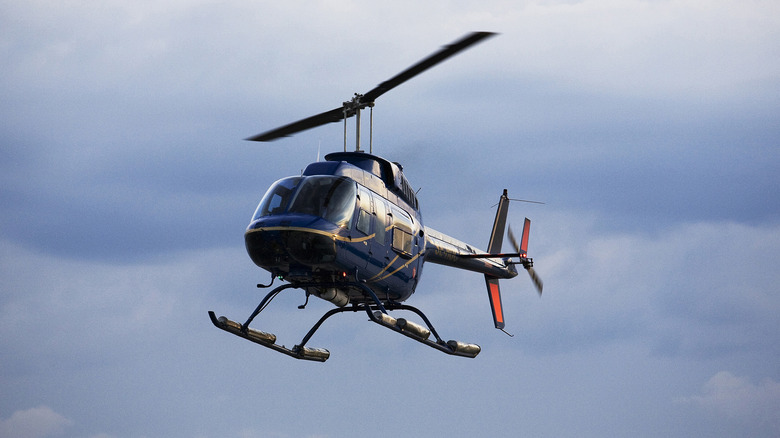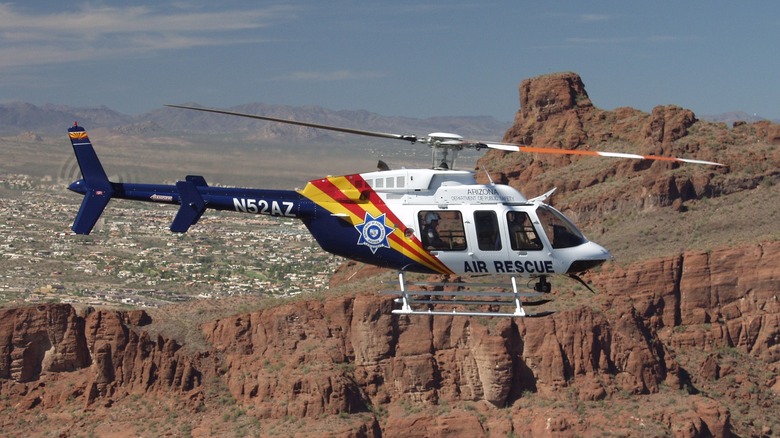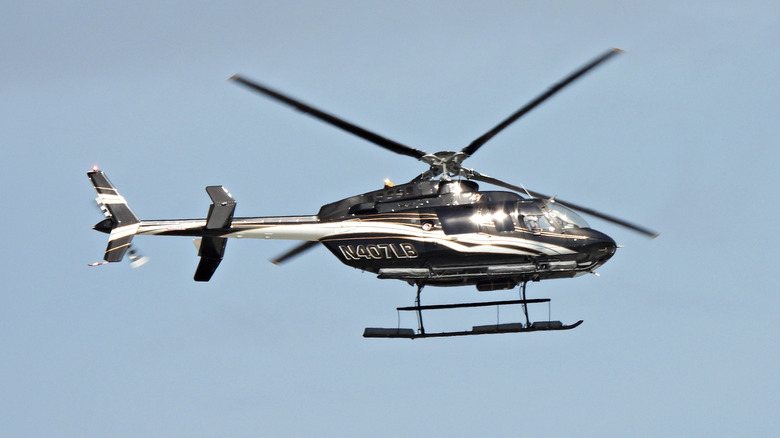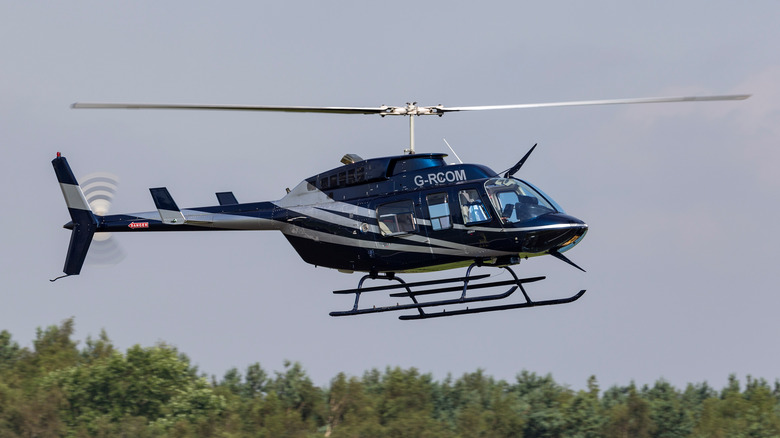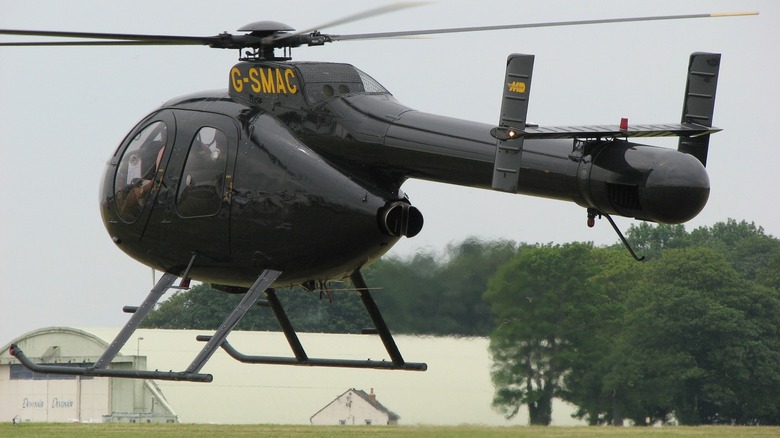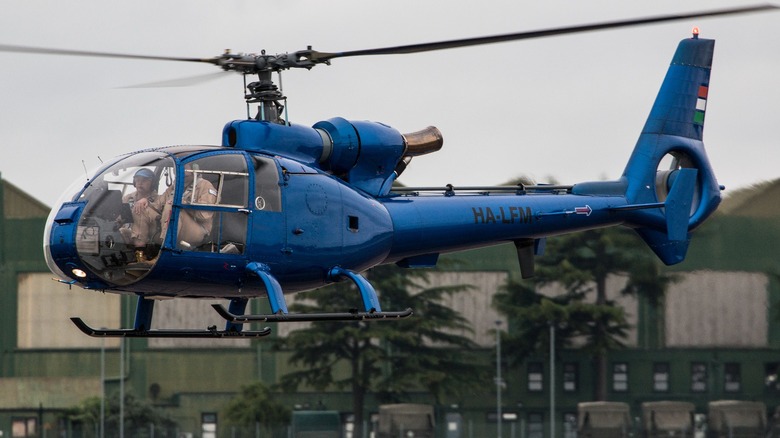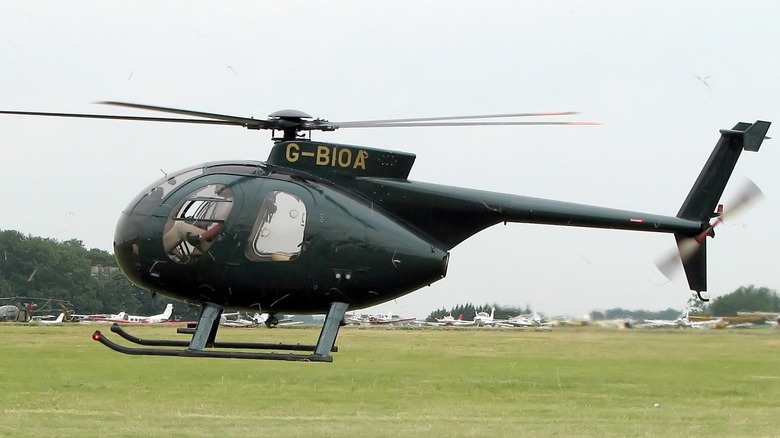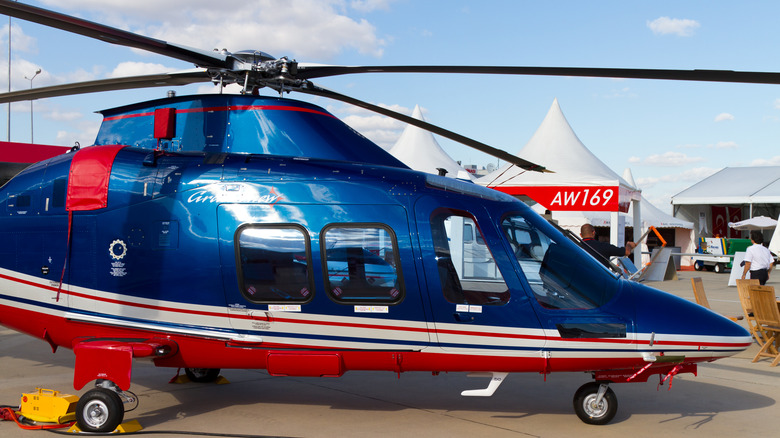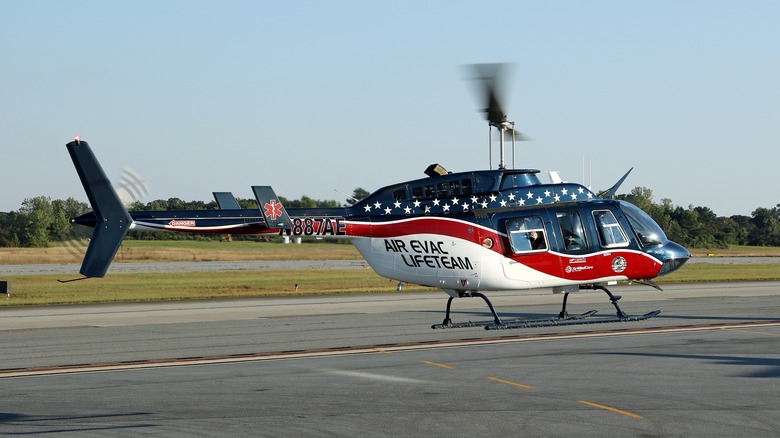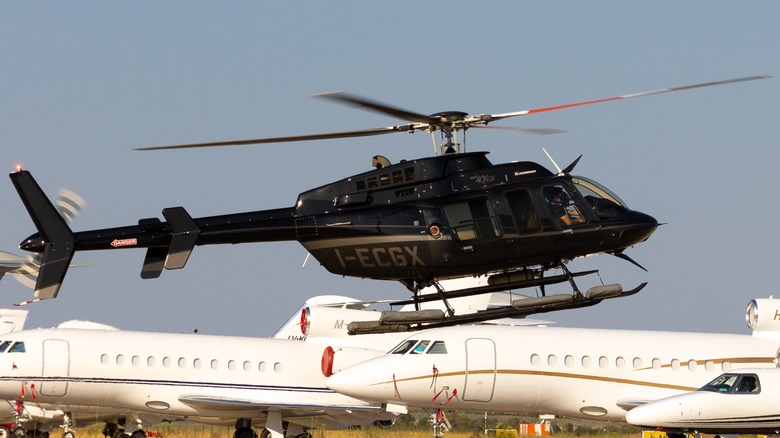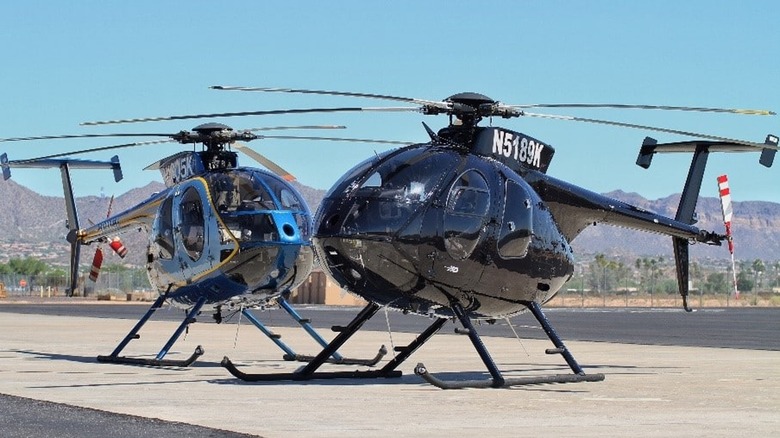10 Of The Fastest Helicopter Flights Ever Recorded
Every mode of transportation has its advantages and disadvantages. For instance, helicopters are known for their ability to take off and land vertically, as well as seamlessly transition between flying forwards, backwards, and sideways. These capabilities come at the cost of speed, but that doesn't mean they're slow.
Thanks to the unique rotor design, helicopters can fill a variety of roles. You can see them hauling cargo, fighting fires, and attacking military targets. Some helicopters are also used for sport. The Fédération Aéronautique Internationale (FAI) is an organization based in Switzerland that specializes in and manages air sports of all stripes. The group keeps track of all sorts of records set by flying vehicles, helicopters included, ranging from top speed to fastest trip around the world.
Here are the ten fastest helicopter speeds recorded by the FAI. This list will only include the current ratified records. Any records that were retired due to changes in the sporting code are not eligible.
244.33 km/h in a Bell 407 in 2021
Traditional logic dictates that people would break more records as time and technology advance. This is why the AH-1Z Viper outperforms the AH-64 Apache; the Viper was built more recently and with superior tech. However, sometimes this isn't the case.
Currently, the tenth-fastest record belongs to Gary L. Maddux Jr, who flew a Bell 407 (a variation of a Bell 406 helicopter) with a 250-C47 engine at 244.33 km/h – that's just under 152 mph. The record was set on April 17, 2021, on a course that stretched from Little Rock, Arizona to Dallas, Texas. On a side note, the Bell 407 was classified as an E-1d, which is given to helicopters that weigh anywhere between 1,750 and 3,000 kg (approximately 3,858 to 6,614 lbs).
Quite ironically, even though this record is one of the most recent ones on this list, it is the worst of the best. With one exception (more on that later), the records for superior speeds were set before Maddux Jr. took flight. Doubly ironically, this won't be the last time the Bell 406 or Maddux Jr. make this list. Still, while plenty of helicopter speed records don't measure up to Maddux Jr.'s accomplishment, one would expect his flight to place higher in the FAI's rankings because of how recently it was attempted. Just goes to show you that expectations are meaningless in the world of record-breaking.
247.35 km/h in a Bell 407 in 2023
What goes into a world record? Practice, for one, but also skill. In competitive helicopter sports, if you try to set one record, odds are you have what it takes to set a few others. The ability to outpace other helicopter pilots overlaps with the fortitude necessary to circumnavigate the world in record time.
On February 3, 2023, Henry Ross Perrot Jr. set a record for flying a Bell 407 with a 250-C47E engine at 247.35 km/h — that's 153.7 mph –between Dallas, Texas and Austin, Texas. And he wasn't alone, as Gary L. Maddux Jr. joined Perrot Jr. as part of the crew. The additional weight did not change the helicopter's subclassification, as it was still labeled as an E-1d at the time of the flight.
This speed record isn't the only time the FAI recognized Perrot Jr.'s skill. In 1982, Perrot Jr. set another speed achievement of 168.78 km/h (just under 105 mph). However, that record was later retired due to changes in the sporting code. The same year, Perrot also set a record for traveling around the world eastward in a helicopter. Unfortunately, the record was later "superseded," i.e., someone broke it. Both times, Perrot Jr. used a Bell 206L-2 Long Ranger with a 250 C28 engine, and J.W. Coburn joined him as his crew.
249.57 km/h in a Bell 206L-3 in 1985
When competing with any vehicle, helicopters included, the vehicle's design, weight, and motor play key roles. Even the slightest fluctuation in weight or horsepower can mean the difference between a world record and wasted effort. However, the pilot is the true deciding factor, as a skilled individual can push their conveyance past expectations and seeming mechanical limitations.
Currently, the eighth-fastest speed record for a helicopter is 249.57 km/h (155 mph) and belongs to Jerry Marlette. He accomplished this feat on July 25, 1985, with a Bell 206L-3 that bore a 250-C30 engine. Furthermore, the course took Marlette from Indianapolis, Indiana to Oshkosh, Wisconsin. For his flight, Harry Sutton and Eric Harvey accompanied Marlette as his crew.
As you can probably guess by their names, Marlette's Bell 206L-3 isn't as advanced as Perrot Jr.'s Bell 407. The helicopter can't fly as fast or carry as much weight, or at least that's what the official specifications would make you think. And yet, Marlette edged out Perrot Jr.'s record by a few km/h, defying the top speed noted in the Bell 206L-3's manual. How was this feat achieved? Only Marlette, Sutton, and Harvey know for sure, but if the FAI didn't immortalize this speed record, you'd probably never believe it was possible.
250.56 km/h in a MD 502 NOTAR in 1992
When someone thinks of a helicopter, they generally imagine a vehicle with giant blades attached to a horizontally spinning rotor, as well as smaller blades secured to a vertically spinning rotor on the tail. However, not all helicopters follow this strict design.
On September 2, 1992, Philip Queffelec set a world speed record of 250.56 km/h (155.7 mph). He flew all the way from Paris, France to London, England in a McDonnell Douglas MD 520 NOTAR with Richard Fenwick as his crewmate. For some reason, the FAI site doesn't list the helicopter's engine. Unlike prior helicopters in this article, Queffelec's MD 520 NOTAR was classified as an E-1c, which is given to rotorcraft between 1,000 and 1,750 kg (2,204.62 to 3,858 lbs).
Unlike every other helicopter on this list, the MD 520 NOTAR stands apart thanks to its unique counterbalance system, the titular NOTAR. This tail-bound component consists of a large fan at the front of the helicopter tail that pushes air through the rear, which creates a pressure differential to counter the main rotor's torque. You don't see this design often — or at all — in the world of helicopters, and the same applies to FAI records, meaning Queffelec's speed entry is one of the few places you might ever see a NOTAR helicopter.
[Image by Adrian Pingstone via Wikimedia Commons | Resized and cropped | Public Domain]
252.18 km/h in an Aérospatiale SA341G Gazelle in 1984
The allure of helicopter sports is strong, as it attracts many pilots of countless stripes and backgrounds. Some come with military experience, while others have less dangerous professions, such as traffic reporters and teachers.
The next highest record recognized by the FAI belongs to Richard Fenwick at 252.18 km/h (156.7 mph). On July 31, 1984, he traveled from London, England to Paris, France in an Aérospatiale SA341G "Gazelle" with an Astazou engine. While this record remains intact, his next attempt wasn't so lucky. On May 29, 1990, Fenwick used a Robinson R22 with an O-320 engine to climb to a height of 3,000 meters (just under 1.9 miles) in 7 minutes and 45 seconds. However, that achievement was later superseded.
Fenwick was once part of the Aero-Club de France. He joined the organization in 1978 and served as its president from 1986 to 1989, and on its Board of Directors in 2006. However, this membership was far from a hobby. Fenwick was an instructor pilot, ran his own helicopter company — Fenwick Hélicoptères — and served as a live traffic reporter from 1990 to 2004. Motorists around Paris recognized Fenwick from his voice and Robinson R22 helicopter. Unfortunately, on July 14, 2008, Fenwick died due to a tragic air accident. He was flying a microlight when it suffered an engine failure and crashed into waters off the coast of Port-des-Barques. No, the crash didn't kill him; he safely landed his vehicle. The cause of death was a heart attack that hit shortly afterward.
[Image by Steve Lynes via Wikimedia Commons | Resized and cropped | CC BY 2.0]
257.61 km/h in an MDD-Hughes 500D in 1990
As you've seen several times throughout this article, many helicopter pilots have tried to set multiple records, only for most to be later supplanted by a better record or rescinded due to changes in codes. However, some pilots have just one record to their name.
On July 26, 1990, Chester William Martin achieved a world speed record of 257.61 km/h (just over 160 mph). He flew from Baltimore, Maryland to Oshkosh, Wisconsin in an MDD-Hughes 500D with a 250 C20 engine. Stephan Martin served as the crew.
Currently, this entry is Chester Martin's only mention in the FAI record book. He doesn't hold any other listings on the site. Perhaps most confusing of all, searching for Chester Martin on Google brings up a 1983 obituary for Chester William Martin Jr., who was the ex-president of the Pepsi-Cola Bottling Co. of Washington and had gone missing in a Piper SuperCub airplane. Clearly not the same person, but it raises some questions as to the identity of Chester William Martin, the helicopter pilot. He seemingly set a world record for fastest helicopter flight and then just vanished — confusing and frustrating for those who want to learn about his accomplishments, or at least about helicopter world records in general.
[Image by Adrian Pingstone via Wikimedia Commons | Resized and cropped | Public Domain]
262.26 km/h in an Agusta A109S Grand in 2008
As previously stated, the skills necessary to achieve many world helicopter records tend to overlap. Someone who has what it takes to travel around the world in record time could also break a speed record. However, not all of these accomplishments are equal in the eyes of the FAI.
One of the FAI's highest records for helicopter speed on a recognized course belongs to Edward Kaprowicz. On February 17, 2008, he flew from New York, NY to Los Angeles, CA at a whopping 262.26 km/h, which is just shy of 163 mph. To accomplish this, Kaprowicz piloted an Agusta A109S Grand (alternatively known as the AW109 Grand or AW109S Grand) with a PW207C engine. Steven Sheik served as his crew. The same year, Kaprowicz set another, albeit slower, record of 136.2 km/h (84.6 mph) while flying from New York, NY to Redhill, England. He used the same helicopter for this flight.
As impressive as these records sound, the FAI mostly recognizes Kasprowicz for his subsequent trip around the world. According to the organization's records, Kasprowicz and Sheik began their flight on August 7, 2008, and ended on August 18. This landed them the record of 11 days, 7 hours, and 2 minutes, which broke the previous 1996 record of 17 days, 6 hours, and 14 minutes. Just so you know, Kasprowicz and Sheik flew up to 13 hours a day and only stopped for two hours to refuel. As strenuous as breaking speed records sounds, flying around the globe is clearly not for the faint of heart.
263.16 km/h in a Bell 206L in 1985
Achieving a record recognized by the FAI is a feat and a half, and many pilots have gone above and beyond to break as many records as they can. However, sometimes not everything goes according to plan, and all but a few records are expunged.
Currently, the third-highest helicopter speed record at the FAI belongs to Frederick Jack Schweibold. On June 21, 1985, he managed to fly 263.16 km/h — that's 163.5 mph — from Indianapolis, Indiana to Traverse City, Michigan. Schweibold used a Bell 206L with a 250-C30 engine and flew with his crewmate Daniel Black.
Going by FAI data, Schweibold used to hold countless other speed records, but they were all retired due to sporting code changes. According to Indianapolis newspaper The Indianapolis Star (via ThisDayinAviation.com), in 1985, Schweibold broke as many as 15 world records for speed, distance, and altitude within the span of two days. This feat could be attributed to Schweibold's background as a test pilot for the Allison Engine Company, as every helicopter he flew when he broke those records, including the Bell 206L, bore an Allison-built engine. However, only thirteen achievements made it to the FAI. Schweibold continued to set FAI records throughout the year, but again, most were retroactively rescinded. Currently, only seven of his achievements remain — four speed records, one distance without landing record, and two "distance over a closed circuit without landing" record. Still, that's still more than most pilots immortalized by the FAI.
274.07 km/h in a Bell 407 in 2020
When you're in the military, you have to be the best of the best because that's what the organization expects and demands. And when you're the best of the best, it's easier to set records. Even when you leave the military, the training stays with you.
On July 19, 2020, Gary L Maddux Jr. set a record for the second-fastest helicopter speed recognized by the FAI: 274.07 km/h (170.3 mph). This achievement is ironic because, as we previously mentioned, he set another record in 2021, but it wasn't anywhere near as fast as this one. During both record attempts, Maddux Jr. used a Bell 407 with a 250-C47 engine. However, instead of flying from Little Rock, Arkansas to Dallas, Texas, he reversed the direction and went from Dallas, Texas to Little Rock, Arkansas.
By now, you're probably wondering just who Maddux Jr. is. He used to be a member of the Marine Corps, and currently he serves as a counselor at the Cardinal Counseling and Wellness Group in Whitehouse, Texas, where he focuses on veterans and first responders. Maddux Jr. is especially interested in helping people with suicidal ideations, as he is also a member of the Touched by Suicide support group board and serves as a volunteer at the Denton County LOSS Team, an organization that helps suicide survivors.
278.71 km/h in an MDD-Hughes 530-F in 1985
Currently, the highest speed record for a rotorcraft belongs to a tiltrotor, a VTOL that can tilt its dual rotors to swap between landing and flight modes. But this article is about helicopters, not tiltrotors. Plenty of helicopter pilots almost matched the speeds set by the tiltrotor, yet they were all thrown out for one reason or another, a fate the current holder for speediest helicopter is all too familiar with.
As of this writing, the top record-holder for fastest helicopter speed recognized by the FAI is Frederick Jack Schweibold. On June 13, 1985, he flew 278.71 km/h (about 173.2 mph) from Oshkosh, Wisconsin to Indianapolis, Indiana. For this flight, he used an MDD-Hughes 530 F with a 250-C30 engine, and he was accompanied by Junior A. Vandervliet.
As previously stated, Schweibold allegedly set as many as 15 records in 1985, and all but seven of them were retired. This June 13th record is one of his few surviving achievements still recognized by the FAI, the irony being that he landed this superior speed record just over a week before his inferior one. But maybe it's not that ironic since the MDD-Hughes 530 F is stronger than the Bell 206 L and can fly further, faster, and with larger loads. If he had used the 530 F for both trials, Schweibold could very well have superseded his own record, thus leaving him with six FAI entries instead of seven.
